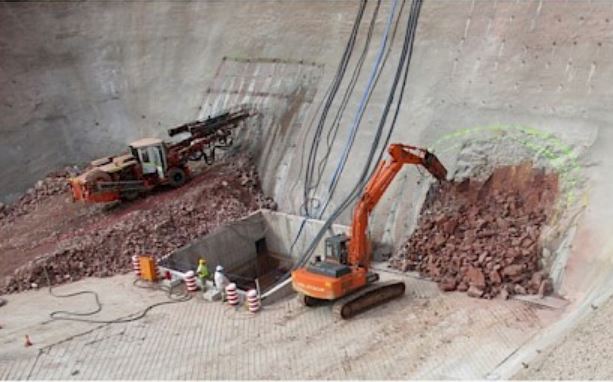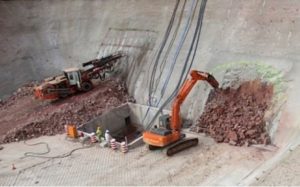DRC uncertainty adds to the bullish outlook for cobalt

Preparing for the first blast for the twin declines at the Kakula box cut in November 15, 2017 in the DRC. Source: Ivanhoe Mines Ltd.
By Peter Kennedy

It is often said that what investors fear most is uncertainty. It explains why shares of Ivanhoe Mines Ltd. [IVN-TSX, IVPAF-OTC] have fallen 26% this week (Jan29 – Feb2) amid reports about changes to the mining code in the Democratic Republic of Congo. These changes are expected to have an immediate impact on every mining project in that country, including two that are being developed by Ivanhoe.
An Ivanhoe source said the biggest concern is a possible 50% tax on so-called super profits, which are defined as income that is realized when commodity prices rise 25% above levels included in the project’s bankable feasibility study.
However, the well-placed source pointed out that Ivanhoe is not yet producing anything in the DRC and any amendments to the existing mining code will not take effect until they are signed into law by DRC President Joseph Kabila.
As a result, worried investors would do well to keep an eye out for any future announcements from Swiss metals trading giant Glencore AG and Rangold Resources Ltd., companies that will be affected most by mining law reforms.
What seems more certain is the future impact on the price of cobalt.
As the DRC currently accounts for about 54% of the world’s cobalt production, any increase in the cost of doing business there may only tighten the supply of a commodity that was already expected to be a top performer in the metals sector this year.
It is worth noting here that the new mining code permits the DRC to raise the royalty on cobalt to 10% from 2% should the government decide that the mineral is a strategic substance.
Cobalt, which is produced primarily as a by-product of copper and nickel (and also occurs with silver near Cobalt, northeast Ontario), has recently become a hot investment area due to its key role in the production of rechargeable batteries used in the manufacture of electric vehicles.
According to Benchmark Mineral Intelligence, battery demand for cobalt is forecast to rise to 76,000 tonnes by the end of 2020, compared to 46,000 tonnes in 2016.
Increasing consumption of battery metals will be driven by the more than 20 mega battery manufacturing plants that are currently being planned or constructed globally, including the gigafactory that Tesla Motors Ltd. [TSLA-NASDAQ] and partner Panasonic Corp. has built in Nevada to support planned production of 500,000 electric cars annually.
Since early 2016, the price of cobalt has more than tripled to over US$36 a pound, the highest level in 10 years.
BMO Capital Markets estimated that global cobalt mine supply was down about 2.7% in 2017, due to weakness at Glencore AG’s Katanga operation in the Democratic Republic of Congo (DRC) and disputes at Groupement du Terril de Lubumbashi’s (GTL) Big Hill primary cobalt tailings operations which are also located in the DRC.
Yet BMO has explained that the cobalt rally is expected to continue with growth in smart phone sales, as Smartphone batteries are still the main end use market for cobalt.
Here are three companies that are active in the cobalt space:
Cruz Cobalt Corp. [CUZ-TSXV, BKTPF-OTC, A2DMG8-Frankfurt] recently completed an airborne survey over the War Eagle and Purcell cobalt prospects in British Columbia and uncovered strong magnetic anomalies. Management is now working diligently on advancing these two cobalt prospects, the company has said.
Cruz currently has eight cobalt properties located throughout North America, consisting of four in Ontario, two in British Columbia, one in Idaho and one in Montana. The four properties in Ontario are located in the vicinity of the town of Cobalt, making Cruz one of the largest landholders in this emerging cobalt district.
The company has tripled its landholdings surrounding the War Eagle prospect. It now has a 100% interest in 15,219 acres on War Eagle and 11,821 acres on the Purcell prospect. “We plan to get on the ground as soon as possible to incorporate the new airborne data with ground proofing,” said Cruz President James Nelson.
Quantum Cobalt Copper Corp. [QBOT-CSE, BRVVF-OTC] is engaged in early stage exploration at the company’s 100%-owned Kahuna and Rabbit Lake Cobalt projects. Both properties are situated in the historic Cobalt, Ontario district, approximately 37 kilometres and 47 kilometres respectively south of the town of Cobalt.
The Kahuna property is comprised of 77 claims, covering about 1,200 hectares. It has already seen some mining activity in the 1920s, yielding about five tonnes of ore, grading 22% cobalt. High grade silver, assaying 20 oz/ton silver, has also been recorded.
Prospecting and sampling at Rabbit Lake has focused on the Rabbit Lake Occurrence, a mineral showing that is described in the Ontario Mineral Deposit inventory. Work is aimed at defining the existing mineral showing and identifying additional mineralization and favourable geology for follow up testing.
US Cobalt Inc. [USCO-TSXV], which is exploring in Idaho, recently raised $6 million from a bought deal private placement to fund a second phase of drilling at US Cobalt’s flagship Iron Creek Cobalt project.
Iron Creek is located in the southeast portion of the Idaho Cobalt Belt. It was discovered in the 1940s and has been explored by a number of companies, including Hanna Mining and more recently Noranda Exploration Inc. Previous operators completed 30,000 feet of diamond drilling and 2,000 feet of underground drifting.
US Cobalt has spent US $4 million on the property, which contains an estimated resource of one million tonnes, averaging 0.61% cobalt and 0.30% copper. But due to the age of geological work that was used to arrive at these estimates, they do not comply with National Instrument 43-101 standards of compliance.
More drilling work will need to be carried out in order to confirm the validity of these estimates.
On January 23, 2018, the company said analytical results from three surface core holes drilled during 2017 at Iron Creek encountered sulphide mineralization with significant cobalt values. “These results confirm that cobalt mineralization exists outside the historical estimate at Iron Creek,” the company said.
